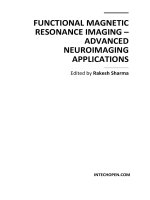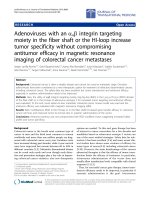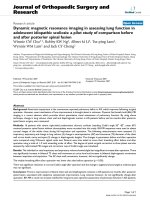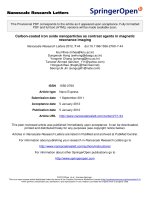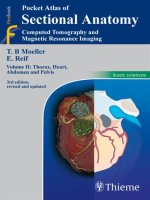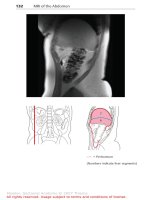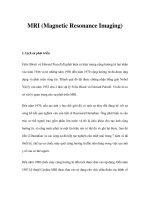Visualization techniques from immunohisto chemistry to magnetic resonance imaging
Bạn đang xem bản rút gọn của tài liệu. Xem và tải ngay bản đầy đủ của tài liệu tại đây (9.25 MB, 319 trang )
NEUROMETHODS
Series Editor
Wolfgang Walz
University of Saskatchewan
Saskatoon, SK, Canada
For further volumes:
/>
wwwwwww
Visualization Techniques
From Immunohistochemistry to Magnetic
Resonance Imaging
Edited by
Emilio Badoer
Professor of Pharmacology, School of Medical Sciences, RMIT University, Bundoora, VIC, Australia
Editor
Emilio Badoer
School of Medical Sciences
RMIT University
Bundoora, VIC, Australia
ISSN 0893-2336
e-ISSN 1940-6045
ISBN 978-1-61779-896-2
e-ISBN 978-1-61779-897-9
DOI 10.1007/978-1-61779-897-9
Springer New York Dordrecht Heidelberg London
Library of Congress Control Number: 2012939062
© Springer Science+Business Media, LLC 2012
All rights reserved. This work may not be translated or copied in whole or in part without the written permission of the
publisher (Humana Press, c/o Springer Science+Business Media, LLC, 233 Spring Street, New York, NY 10013, USA),
except for brief excerpts in connection with reviews or scholarly analysis. Use in connection with any form of information
storage and retrieval, electronic adaptation, computer software, or by similar or dissimilar methodology now known or
hereafter developed is forbidden.
The use in this publication of trade names, trademarks, service marks, and similar terms, even if they are not identified
as such, is not to be taken as an expression of opinion as to whether or not they are subject to proprietary rights.
While the advice and information in this book are believed to be true and accurate at the date of going to press, neither
the authors nor the editors nor the publisher can accept any legal responsibility for any errors or omissions that may be
made. The publisher makes no warranty, express or implied, with respect to the material contained herein.
Printed on acid-free paper
Humana Press is part of Springer Science+Business Media (www.springer.com)
Preface to the Series
Under the guidance of its founders Alan Boulton and Glen Baker, the Neuromethods series
by Humana Press has been very successful since the first volume appeared in 1985. In about
17 years, 37 volumes have been published. In 2006, Springer Science + Business Media
made a renewed commitment to this series. The new program will focus on methods that
are either unique to the nervous system and excitable cells or which need special consideration to be applied to the neurosciences. The program will strike a balance between recent
and exciting developments like those concerning new animal models of disease, imaging,
in vivo methods, and more established techniques. These include immunocytochemistry
and electrophysiological technologies. New trainees in neurosciences still need a sound
footing in these older methods in order to apply a critical approach to their results. The
careful application of methods is probably the most important step in the process of scientific
inquiry. In the past, new methodologies led the way in developing new disciplines in the
biological and medical sciences. For example, Physiology emerged out of Anatomy in the
nineteenth century by harnessing new methods based on the newly discovered phenomenon of electricity. Nowadays, the relationships between disciplines and methods are more
complex. Methods are now widely shared between disciplines and research areas. New
developments in electronic publishing also make it possible for scientists to download chapters or protocols selectively within a very short time of encountering them. This new
approach has been taken into account in the design of individual volumes and chapters in
this series.
Wolfgang Walz
v
wwwwwww
Preface
Visualization of chemicals in tissues has seen an incredible advance in the last few years. The
array of visualization techniques has expanded to include immunohistochemistry for multiple neurochemicals, detecting expression levels of neurochemicals, following cellular processes and ionic movement, and identifying polysynaptic pathways subserving physiological
responses to identifying functional changes in vivo. The present volume provides practical
advice as well as an excellent overview of some of the advances in visualization that have
been made in recent years. In Chap. 1, well-established procedures for multiple-labelling
immunofluorescence in peripheral neurons are described, including the necessary and
important critical controls in all stages of the process. In Chap. 2, a procedure for combining
non-radioactive in situ hybridization histochemistry with multi-label fluorescence immunohistochemistry on rat brain tissue is presented to facilitate the visualization of multiple
mRNA and protein targets located within subcellular compartments. Chapter 3 provides
details of a novel method that combines radioactive in situ hybridization histochemistry
with immunofluorescence. This method will be particularly useful for investigators looking
to identify cell populations producing mRNAs expressed in low abundance. In Chap. 4,
confocal laser scanning microscopy and multiple immunofluorescence analysis is described
to study constitutive GABAB receptor internalization and intracellular trafficking. In Chap. 5,
a new powerful application of fluorescence microscopy called Total Internal Reflection
Fluorescence Microscopy is described. This method allows selective imaging of fluorescent
molecules that are either in or close to the plasma membrane of a cell, such as the trafficking
and exocytosis of the glucose transporter, GLUT4, in response to insulin stimulation. In
Chap. 6, a visualization protocol for automated temporal analysis of mitochondrial position
in living cells is described, and how it can be used for computer-assisted quantification of
mitochondrial morphology and membrane potential is discussed.
In Chap. 7, the advantages, shortcomings, and possible developments of two-photon
microscopy applied to imaging neurons and cells in living tissue are presented. Exciting
recent developments in high-speed imaging of 3D objects are also given particular attention. In Chap. 8, techniques that have been optimized to measure [Ca2+] dynamics in neocortical dendrites in response to physiological patterns of APs are described, and the
importance of quantifying the dendritic Ca2+ dynamics with a high spatial and temporal
resolution using two-photon imaging is detailed. In Chap. 9, the technique of extracellular
recording combined with juxtacellular labelling is described, and its application to the characterization of cardiorespiratory brainstem neurons is discussed, although this technique
could be applied to any neuron. In Chap. 10, the development of transgenic mice expressing fluorescent proteins under the control of specific neuropeptide promoters describes
how such animals enable direct visualization of specific cell population within the central
nervous system. Techniques aimed at detecting activated neurons, using the protein cFos
as a marker, can be combined with tissue from these animals to provide a powerful method
vii
viii
Preface
of detecting peptides expressed at low levels in activated neuronal populations. In Chap. 11,
an overview of guidelines for the use of pseudorabies virus for transneuronal tracing is
provided. This fabulous technique exploits the abilities of neurotropic viruses to invade
neurons and generate infectious progeny that cross synapses to infect other neurons within
a circuit. The method has become increasingly popular with the development of recombinant strains of virus that are reduced in virulence and express unique reporters allowing
different pathways to different organs to be explored in the same animal. In Chap. 12, the
use of digital infrared thermography is discussed to detect changes in skin vasoconstriction,
body temperature, brown adipose tissue thermogenesis, and nociception in the conscious
and unrestrained rat. All these physiological phenomena are measured remotely through
emitted infrared radiation. Finally, in Chap. 13, the method known as dynamic susceptibilitycontrast magnetic resonance imaging is discussed in regard to assessment of brain perfusion
and tissue hemodynamics. The typical steps involved in this technique are described. The
problems and the approaches that have been developed to counter them are discussed.
The authors and I believe you will find this volume invaluable in gaining an understanding of the practical skills, strengths, and pitfalls that these wonderful and exciting
visualization techniques provide.
Bundoora, VIC, Australia
Emilio Badoer
(Professor of Pharmacology)
Contents
Preface to the Series. . . . . . . . . . . . . . . . . . . . . . . . . . . . . . . . . . . . . . . . . . . . . . . . . . . .
Preface. . . . . . . . . . . . . . . . . . . . . . . . . . . . . . . . . . . . . . . . . . . . . . . . . . . . . . . . .
Contributors. . . . . . . . . . . . . . . . . . . . . . . . . . . . . . . . . . . . . . . . . . . . . . . . . . . . .
v
vii
xi
1 Multiple Immunohistochemical Labelling of Peripheral Neurons. . . . . . . . . .
Ian L. Gibbins
2 Combined In Situ Hybridization and Immunohistochemistry in Rat Brain
Tissue Using Digoxigenin-Labeled Riboprobes . . . . . . . . . . . . . . . . . . . . . .
Natasha N. Kumar, Belinda R. Bowman, and Ann K. Goodchild
3 In Situ Hybridization Within the CNS Tissue: Combining
In Situ Hybridization with Immunofluorescence . . . . . . . . . . . . . . . . . . . . . .
Dominic Bastien and Steve Lacroix
4 Visualizing GABAB Receptor Internalization
and Intracellular Trafficking . . . . . . . . . . . . . . . . . . . . . . . . . . . . . . . . . . . . .
Paola Ramoino, Paolo Bianchini, Alberto Diaspro, and Cesare Usai
5 Using Total Internal Reflection Fluorescence Microscopy (TIRFM)
to Visualise Insulin Action. . . . . . . . . . . . . . . . . . . . . . . . . . . . . . . . . . . . . . .
James G. Burchfield, Jamie A. Lopez, and William E. Hughes
6 Live-Cell Quantification of Mitochondrial Functional Parameters . . . . . . . . .
Marco Nooteboom, Marleen Forkink, Peter H.G.M. Willems,
and Werner J.H. Koopman
7 Functional Imaging Using Two-Photon Microscopy in Living Tissue . . . . . .
Ivo Vanzetta, Thomas Deneux, Attila Kaszás, Gergely Katona,
and Balazs Rozsa
8 Calcium Imaging Techniques In Vitro to Explore the Role of Dendrites
in Signaling Physiological Action Potential Patterns. . . . . . . . . . . . . . . . . . . .
Audrey Bonnan, Benjamin Grewe, and Andreas Frick
9 Juxtacellular Labeling in Combination with Other Histological
Techniques to Determine Phenotype of Physiologically
Identified Neurons . . . . . . . . . . . . . . . . . . . . . . . . . . . . . . . . . . . . . . . . . . . .
Ruth L. Stornetta
10 Visualization of Activated Neurons Involved in Endocrine and Dietary
Pathways Using GFP-Expressing Mice . . . . . . . . . . . . . . . . . . . . . . . . . . . . .
Rim Hassouna, Odile Viltart, Lucille Tallot, Karine Bouyer,
Catherine Videau, Jacques Epelbaum, Virginie Tolle,
and Emilio Badoer
1
ix
31
53
71
97
111
129
165
189
207
x
Contents
11 Use and Visualization of Neuroanatomical Viral
Transneuronal Tracers. . . . . . . . . . . . . . . . . . . . . . . . . . . . . . . . . . . . . . . . . .
J. Patrick Card and Lynn W. Enquist
12 Visualisation of Thermal Changes in Freely Moving Animals . . . . . . . . . . . . .
Daniel M.L. Vianna and Pascal Carrive
13 Perfusion Magnetic Resonance Imaging Quantification in the Brain . . . . . . .
Fernando Calamante
Index . . . . . . . . . . . . . . . . . . . . . . . . . . . . . . . . . . . . . . . . . . . . . . . . . . . . . . . . . . . . . .
225
269
283
313
Contributors
EMILIO BADOER • School of Medical Sciences, RMIT University, Bundoora,
VIC, Australia
DOMINIC BASTIEN • Laboratory of Endocrinology and Genomics, CHUL Research
Centre, Québec City, QC, Canada; Department of Molecular Medicine,
Université Laval, Québec City, QC, Canada
PAOLO BIANCHINI • Italian Institute of Technology (IIT), Genoa, Italy
AUDREY BONNAN • Institut National de la Santé et de la Recherche Médicale
(INSERM) Unité 862, Circuit and dendritic mechanisms underlying cortical
plasticity, NeuroCentre Magendie, Bordeaux, France
KARINE BOUYER • Centre de Psychiatrie et Neurosciences, UMR894 INSERM,
Université Paris Descartes, Sorbanne Paris Cité, Paris, France
BELINDA R. BOWMAN • The Australian School of Advanced Medicine, Macquarie
University, Sydney, NSW, Australia
JAMES G. BURCHFIELD • The Garvan Institute of Medical Research, Sydney,
NSW, Australia
FERNANDO CALAMANTE • Fernando Calamante, Brain Research Institute,
Florey Neuroscience Institutes, Melbourne Brain Centre, Heidelberg, Victoria,
Australia
J. PATRICK CARD • Department of Neuroscience, University of Pittsburgh, Pittsburgh, PA,
USA
PASCAL CARRIVE • School of Medical Sciences, University of New South Wales, Sydney, NSW,
Australia
THOMAS DENEUX • The Weizmann Institute of Sciences, Rehovot, Israel
ALBERTO DIASPRO • Italian Institute of Technology (IIT), Genoa, Italy;
Department of Physics (DIFI), University of Genoa, Genova, Italy
LYNN W. ENQUIST • Department of Molecular Biology, Princeton University,
Princeton, NJ, USA
JACQUES EPELBAUM • Centre de Psychiatrie et Neurosciences, UMR894 INSERM,
Université Paris Descartes, Sorbanne Paris Cité, Paris, France
MARLEEN FORKINK • Department of Biochemistry, Nijmegen Centre for Molecular Life Sciences, Radboud University Nijmegen Medical Centre, Nijmegen, The Netherlands
ANDREAS FRICK • Circuit and dendritic mechanisms underlying cortical plasticity, NeuroCentre Magendie, Institut National de la Santé et de la Recherche Médicale (INSERM)
Unité 862, Bordeaux, France
IAN L. GIBBINS • Department of Anatomy and Histology, and Centre for Neuroscience,
School of Medicine, Flinders University, Adelaide, SA, Australia
ANN K. GOODCHILD • The Australian School of Advanced Medicine, Macquarie
University, Sydney, NSW, Australia
xi
xii
Contributors
BENJAMIN GREWE • Department of Neurophysiology, Brain Research Institute,
University of Zurich, Zurich, Switzerland
RIM HASSOUNA • Centre de Psychiatrie et Neurosciences, UMR894 INSERM,
Université Paris Descartes, Sorbanne Paris Cité, Paris, France
WILLIAM E. HUGHES • The Garvan Institute of Medical Research, Sydney, NSW,
Australia; Department of Medicine, St. Vincent’s Hospital, Sydney, NSW, Australia
ATTILA KASZÁS • Institute of Experimental Medicine, Hungarian Academy of Sciences,
Budapest, Hungary; Pázmány Péter Catholic University, Budapest, Hungary
GERGELY KATONA • Institute of Experimental Medicine, Hungarian Academy
of Sciences, Budapest, Hungary
WERNER J.H. KOOPMAN • Department of Biochemistry, Nijmegen Centre for
Molecular Life Sciences and Centre for Systems Biology and Bioenergetics,
Radboud University Nijmegen Medical Centre, Nijmegen, The Netherlands
NATASHA N. KUMAR • The Australian School of Advanced Medicine, Macquarie
University, Sydney, NSW, Australia
STEVE LACROIX • Laboratory of Endocrinology and Genomics, CHUL Research Centre,
Québec City, QC, Canada; Department of Molecular Medicine, Université Laval, Québec
City, QC, Canada
JAMIE A. LOPEZ • The Garvan Institute of Medical Research, Sydney, NSW, Australia;
Peter MacCallum Cancer Centre, East Melbourne, VIC, Australia
MARCO NOOTEBOOM • Departments of Biochemistry and Pediatrics, Nijmegen Centre for
Molecular Life Sciences, Nijmegen Centre of Mitochondrial Disorders, Centre for Systems
Biology and Bioenergetics, Radboud University Nijmegen Medical Centre, Nijmegen, The
Netherlands
PAOLA RAMOINO • Department of Territory and Its Resources (DIP.TE.RIS),
University of Genoa, Genoa, Italy
BALAZS ROZSA • Institute of Experimental Medicine, Hungarian Academy of Sciences, Budapest, Hungary; Pázmány Péter Catholic University, Budapest, Hungary
RUTH L. STORNETTA • Department of Pharmacology, University of Virginia,
Charlottesville, VA, USA
LUCILLE TALLOT • Centre de Psychiatrie et Neurosciences, UMR894 INSERM,
Université Paris Descartes, Sorbanne Paris Cité, Paris, France
VIRGINIE TOLLE • Centre de Psychiatrie et Neurosciences, UMR894 INSERM,
Université Paris Descartes, Sorbanne Paris Cité, Paris, France
CESARE USAI • Institute of Biophysics, CNR, Genoa, Italy
IVO VANZETTA • INT, CNRS UMR 7289, Marseille, France;
Aix-Marseille Université, Marseille, France
DANIEL M.L. VIANNA • School of Medical Sciences, University of New South Wales,
Sydney, NSW, Australia
CATHERINE VIDEAU • Centre de Psychiatrie et Neurosciences, UMR894 INSERM,
Université Paris Descartes, Sorbanne Paris Cité, Paris, France
ODILE VILTART • Laboratoire “Développement et Plasticité du cerveau post-natal”,
Centre de recherche JPARC, UMR837 INSERM, Lille, France; Université Nord
de France (USTL), Lille, France
PETER H.G.M. WILLEMS • Department of Biochemistry, Nijmegen Centre for
Molecular Life Sciences and Centre for Systems Biology and Bioenergetics,
Radboud University Nijmegen Medical Centre, Nijmegen, The Netherlands
Chapter 1
Multiple Immunohistochemical Labelling
of Peripheral Neurons
Ian L. Gibbins
Abstract
This chapter describes well-established procedures for multiple-labelling immunofluorescence as applied to
peripheral neurons. Tissues are fixed with a mixture of formaldehyde and picric acid, and then processed
through solvents (ethanol and dimethyl sulfoxide or xylene) before preparation as sections (frozen or
embedded in polyethylene glycol) or whole mounts. Specimens are exposed to small volumes of antibody
mixtures and are then mounted in buffered glycerol prior to examination with fluorescent microscope
fitted with appropriate optics for multi-labelling fluorescence. Critical controls are summarised for all
stages of the process, including the specificity of the primary antibodies, the secondary antibodies, and the
subsequent image acquisition and analysis.
Key words: Immunofluorescence, Multiple labelling, Co-localisation, Peripheral neurons,
Fluorescence microscopy, Confocal microscopy
1. Introduction
The development and routine application of indirect immunofluorescence procedures during the 1970s and 1980s has revolutionised the microscopic analysis of neuronal structure and function.
With the easy availability of a wide range of fluorophores, improved
microscope optics, high-sensitivity detectors and powerful postacquisition image processing, high-quality multiple-labelling
immunofluorescence can be a standard methodology in any neuroscience laboratory. Nevertheless, although the procedures are
robust when applied rigorously, there are many variables that will
lead to inferior results if not adequately controlled. These variables
include tissue fixation and post-fixation processing, choice of antibodies, storage and handling of the specimens, and microscope
Emilio Badoer (ed.), Visualization Techniques: From Immunohistochemistry to Magnetic Resonance Imaging, Neuromethods,
vol. 70, DOI 10.1007/978-1-61779-897-9_1, © Springer Science+Business Media, LLC 2012
1
2
I.L. Gibbins
setups. In this chapter, I will present some robust methods that we
have been using for more than 20 years now for the immunohistochemical study of peripheral autonomic and sensory neurons in
nearly every tissue of the body. Although I will concentrate on
labelling mammalian peripheral neurons, we have applied these
methods across many species of fish, amphibians, reptiles, birds
and mammals.
1.1. Some Basic
Theory and
Background
Immunohistochemistry is based on the principle that antibodies
recognise specific molecular structures (epitopes), typically a short
sequence of amino acids from a peptide or protein. High quality
immunohistochemical labelling then depends on a combination of
the specificity and sensitivity of the interactions between the antibodies and their presumed targets, as well as the methods used to
visualise these interactions.
The most common methods of multiple-labelling immunofluorescence use primary antibodies that are raised in different host
species (e.g. mouse, rabbit, goat). These primary antibodies are
then labelled with secondary antibodies raised in another species
(e.g. donkey) against immunoglobins of the primary antibody host
species (e.g. a donkey antibody to rabbit IgG). In turn, secondary
antibodies are labelled with different fluorophores, each excited
and emitting at characteristic wavelengths that can be distinguished
with appropriate optical systems.
In principle, multiple labelling can be done with light absorbing markers generated by enzymatic labels such as horseradish peroxidase or alkaline phosphatase. However, their applicability is
much more limited, especially for detailed co-localisation analyses,
and they will not be discussed further here.
Probably the most critical steps in these methods are (1) the
choice of appropriate antibodies; (2) tissue fixation and post-fixation
processing and (3) setting up of the fluorescence microscope.
1.2. Choice
of Appropriate Primary
Antibodies
Investigators are now faced with a vast array of primary antibodies
that are potentially suitable for immunofluorescence. Unfortunately,
even after matching protocols and tissues with those suggested by
the suppliers, only a relatively small proportion work as advertised.
Most commonly, no labelling at all is seen (1). Alternatively, any
apparent labelling that does occur is clearly artefactual (2, 3). When
selective labelling occurs, the signal-to-noise ratio maybe too poor
for effective use, either because the labelling is weak compared with
background or because there is a mixture of selective and non-selective
labelling. Finally, even if an apparently high level of selectivity is
found, it is still necessary to show that the labelling observed is
sufficiently specific to be of value. Many journals aiming to publish
high-quality immunohistochemical studies (most notably the Journal
of Comparative Neurology) now insist on detailed documentation of
the specificity and selectivity of antibodies used in the work (4).
1
Multiple Immunohistochemical Labelling of Peripheral Neurons
3
Fig. 1. Basic principles of triple-labelling immunofluorescence. (a) Three epitopes (a,b,c) localised with primary antibodies
raised in different host species: a rabbit antibody to epitope a (r a a), a mouse antibody to epitope b (m a b) and a goat
antibody to c (g a c). All the secondary antibodies are raised in donkeys and each is coupled to a different fluorophore
(indicated by different shaped stars). (b) An example of a cross-reactivity control for secondary antibodies. This test checks
that only the donkey anti-rabbit (d a r) secondary antibody binds to the rabbit primary antibody to epitope a (r a a). No
labelling should be seen with the other two secondary antibodies. If any labelling is seen, it could be due to cross-reactivity
with the inappropriate primary antibody host species, binding to the correct secondary antibody already bound to the
primary (rare, but it does happen), or the secondary antibody binding directly to tissue components (also rare unless the
tissue is from the same species as the immunoglobin targeted by the secondary in question, e.g. a mouse in this example).
(c) The problem of mixing secondary antibodies raised in different host species. Here the donkey anti-goat immunoglobin
secondary (d a g) will bind to the goat anti-mouse immunoglobin secondary antibody (g a m).
When considering multiple-labelling immunofluorescence the
choice of host species matters. Ideally, all the primary antibodies
need to be raised in different host species, and none of those can
be the same the species in which the labelling will be done (Fig. 1).
Whilst there are methods for multiple-labelling with conspecific
primary antibodies (e.g. elute and re-label; use of Fab fragments as
secondary antibodies, (5)), in our hands, none works reliably under
4
I.L. Gibbins
routine conditions. Although rarely a problem in the central nervous
system, primary antibodies raised in the same species as that being
labelled are rarely useful (e.g. mouse monoclonal antibodies used
on mouse peripheral tissue). In this case, the secondary antibodies
bind to not only the target primary antibody but all the native
immunoglobins that permeate the tissue, usually leading to insurmountable background labelling.
A significant potential problem for testing the specificity and
sensitivity of antibodies for immunohistochemistry is that the
physico-chemical conditions of fixed tissues are not the same as
unfixed frozen tissues, and even less like those in an SDS–PAGE
gel commonly used for Western Blots or in environment of an
immunoassay (e.g. radioimmunoassay or ELISA). Thus, an antibody that is highly selective and sensitive for detecting a particular
protein in a Western Blot may be totally ineffective in detecting the
same protein in the same source tissue processed for immunohistochemistry (1).
While immunohistochemistry can be done on unfixed tissue,
albeit usually after snap freezing at liquid nitrogen temperature,
generally tissue is fixed with a cross-linking agent (5). The most
common of these is formaldehyde. Cross-linking fixatives optimally
bind to amine groups (e.g. on lysine) and create a polymeric meshwork that hopefully preserves the overall spatial localisation of the
proteins of interest, whilst also maintaining access of the primary
antibodies to the epitopes they are supposed to target. This environment is not only different from the strongly denaturing
environment of SDS–PAGE but also is quite different from the
natural tissue environment in which the antibodies were generated
in the first place.
Testing the specificity of an antibody for multiple-labelling
immunohistochemistry can be a tedious exercise. At an absolute
minimum, any labelling should be abolished by pre-incubating the
antibody with a sample of the peptide sequence or protein against
which the antibody was raised (an “absorption test”). A range of
concentrations of the “blocking peptide” should be used, and ideally,
compared with a different peptide sequence, since high concentrations of peptide (e.g. greater than 0.1 mM) may block the binding
of any antibody. In multiple labelling, it is necessary to check all
primary antibodies for cross-reactivity with the other sequences
being co-labelled (4).
While absorption tests demonstrate that an antibody recognises its intended target sequence, they do not rule out the possibility that it might recognise a similar epitope in an unrelated peptide
or protein. For largely unknown reasons, many antibodies bind
non-specifically to material in the nucleus or endoplasmic reticulum and Golgi apparatus. The best defence against this outcome is
to use at least two different antibodies that have been raised against
different epitopes of the same protein of interest. If such a pair of
1
Multiple Immunohistochemical Labelling of Peripheral Neurons
5
antibodies shows different labelling patterns, then the first assumption
must be that one of them (at least!) is binding to a compound
other than its intended target.
1.3. Choice
of Appropriate
Secondary Antibodies
There are two main issues to consider with secondary antibodies for multiple labelling: (1) avoiding cross-reactivity with
undesirable target immunoglobins and (2) selecting appropriate
fluorophores that match both the tissue characteristics and the
microscope setup.
All secondary antibodies need to be tested for cross-reactivity
to immunoglobins from non-target species. Buying affinitypurified antibodies (most of them are) does not insure against this
problem. However, several manufacturers offer secondary antibodies that have been pre-absorbed against a large range of non-target
immunoglobins (e.g. Jackson ImmunoResearch; Rockland). In our
experience, these antibodies are very good, but occasional crossreactions still turn up: just because your donkey anti-rabbit IgG
does not cross-react with any of your current antibodies raised in
sheep, it does not mean that it will not cross-react with the next
one you use!
When doing multiple labelling, it is essential that none of the
secondary antibodies is raised in the same species as any of the primaries (Fig. 1). For example, if you have primaries raised in a
mouse and in a goat, you cannot use an anti-mouse IgG secondary
raised in a goat. Ideally all the secondary antibodies should be raised
in the same host species (e.g. donkeys) to minimise the likelihood
of them binding to each other.
Fluorophores generally work by absorbing light of a given
wavelength and emitting light at a longer wavelength (6). The size
of the difference in peak excitation and emission wavelengths is
known as Stokes shift. Both the excitation and emission wavelengths can have relatively large effective ranges away from their
peaks, and much care needs to be taken to ensure that the
fluorophores that are used match the filter combinations available
on the microscopes and vice versa. For example, use of common
pairs of green and red fluorophores (e.g. fluorescein and rhodamine, or Alexa488 and Cy3) requires narrow band-pass excitation and emission filters to minimise both cross-excitation (i.e. the
red fluorophore being excited by the wavelengths intended for the
green fluorophore) and bleed-through (e.g. fluorescence from the
“red” label being visible through the “green” filter; see Sect. 1.5).
For critical co-localisation studies, the use of fluorophores with
non-overlapping spectral characteristics (e.g. fluorescein and Cy5)
effectively eliminates this risk.
Tissue background fluorescence. The choice of secondary antibody
also depends to some degree on tissue background fluorescence.
Many tissue components are autofluorescent, often over a large
proportion of the visible spectrum. Common offenders include
6
I.L. Gibbins
haemoglobin, collagen, elastin, keratin, myelin and lipofuscin.
In general, these substances are more fluorescent at shorter excitation wavelengths (e.g. near UV to green). They have much reduced
fluorescence at longer excitation wavelengths (e.g. red or near IR),
such as those used to excite Cy5. Long-wavelength fluorophores
have the additional advantage of reduced fading rates.
Enhanced fluorescence signal. Finally, when signal levels are low, but
signal-to-noise ratios are relatively high, additional signal
amplification can be achieved via the choice of secondary antibody
(5). The easiest and most common approach is to use a biotinylated secondary antibody for the weakest primary label in the combination followed by streptavidin (or a proprietary variant) linked
to the fluorophore of choice. Other amplification options include
tyramide-enhancement procedures and their variants. Both procedures carry risks of making things worse: many peripheral tissues
seem to contain endogenous binding sites for streptavidin; and
tyramide amplification also enhances any background binding of
the original primary antibody. In each case, signal-to-noise ratios
become critical issues that will not be improved by any amplification
procedure.
1.4. Tissue Fixation
and Post-fixation
Processing
Fixatives. As mentioned earlier, most fixatives for immunohistochemistry work primarily by cross-linking proteins (5). The best
known cross-linking fixative is formaldehyde. It is a small molecule,
allowing rapid tissue penetration, but forms relatively weak crosslinks. Glutaraldehyde, a dialdehyde, is an even better cross-linking
fixative, which makes it an ideal primary fixative for electron microscopy. However, it has two significant disadvantages for
immunofluorescence: it is strongly autofluorescent across a broad
range of wavelengths, thereby creating very high background; this
characteristic is compounded by the bivalent nature of the fixative,
since free aldehyde groups can cross-link antibodies to the tissue,
thereby increasing non-specific fluorescence even more.
A very widely used fixative for immunofluorescence (Zamboni’s
fixative) combines formaldehyde with picric acid (2,4,6-trinitrophenol). Although the chemistry of picric acid fixation is still not
known, a combination formaldehyde–picric acid fixative is an
excellent general purpose fixative for peripheral tissues that, in our
experience, tends to reduce tissue autofluorescence and improve
antibody penetration compared with fixation in formaldehyde
alone (7).
Cross-linking reagents may not work so well for some types of
proteins, especially cell membrane constituents, such as receptors
and ion channels. Instead, rapid freezing in isopentane cooled to
liquid nitrogen temperatures may be a suitable alternative. Fixation
with ice-cold acetone or methanol are other options to explore
when aldehyde fixatives fail to preserve immunoreactivity of membrane proteins.
1
Multiple Immunohistochemical Labelling of Peripheral Neurons
7
Fig. 2. Whole mount of guinea pig pericardium containing varicose sensory nerve fibres double labelled for the neuropeptide, substance P (a) and the synaptic vesicle protein, synaptophysin (b). The whole mount preparation clearly shows the
overall arrangement of the fibres in a way that would be impossible to determine from sections. In this case, varicosities
labelled with each marker probably represent different nerve fibres even though they run in the same nerve fibre bundles.
A ×40 objective was used here, wide-field microscopy.
Sections or whole mounts? Traditionally, immunohistochemistry is
done on tissue sections, as in conventional histology. However,
many peripheral tissues lend themselves to preparation as whole
mounts. Whole-mount preparations have the immense advantage
of visualising the three-dimensional organisation of peripheral neurons throughout relatively large samples of tissue ((7); Fig. 2). The
value of this approach is limited by the distance that antibodies can
penetrate the tissue.
Despite the value of whole mounts, some tissues are better
examined using sections. Whilst wax embedding as used in conventional histology facilitates serial sectioning, the strongly hydrophobic environment of the wax combined with the relatively high
temperatures required even for “low melting point” wax leads to a
loss of immunoreactivity compared with other methods. Presumably
this is due to variable degrees of protein denaturation. Antigenicity
can be restored to various degrees by antigen retrieval methods.
However, such methods tend to be adapted to specific situations
and are not suitable for routine use.
A well-proven method for sectioning peripheral tissue for
multiple-labelling immunofluorescence is the use of a freezing
microtome (cryostat). However, freezing tissue blocks and subsequent section sublimation onto glass slides can lead to structural
8
I.L. Gibbins
artefacts in tissue, even if appropriate cryoprotectants are used. An
alternative for peripheral ganglia (but not peripheral tissues themselves) is polyethylene glycol (PEG) embedding (8). A big advantage of this method is its minimal spatial distortion of the tissue.
Once cut, PEG sections are placed into buffered saline which dissolves the PEG, thereby eliminating any support for the tissue by
the embedding medium. This means that PEG sections can only
be used for tissues that hold themselves together once sectioned
(e.g. peripheral ganglia, (8–10)). Most peripheral tissues (e.g. gut,
urinary bladder, skin, blood vessels, etc.) will not do this and are
better examined with cryostat sections or whole mounts.
Antibody penetration. No matter how tissue is fixed and sectioned,
there usually must be a processing step that allows large immunoglobin molecules to penetrate the tissue, and, even more importantly, especially in whole mounts, cross cell membranes. The
most widely used solution to this problem is to treat sections with
detergent either prior to or together with application of the primary antibodies (5). A superior alternative, that causes less overall
tissue damage, is to treat the tissue with solvent (e.g. ethanol,
xylene or dimethyl sulfoxide), prior to embedding and sectioning
(8). Such pre-treatment is vital for immunohistochemistry of
whole mounts (7).
Mounting and storing labelled tissue. Once the tissues have been
treated with primary and then secondary antibodies, they need to
be mounted in a medium that both clears the tissue (i.e. matches
the refractive indices of the tissue and the coverslip glass) and
inhibits fading of the fluorophores. Fluorophore fading seems to
be due mostly to oxidation. Some commercial mounting agents act
to secure the coverslip, match the refractive index and act as an
antioxidant. However, whilst reducing fading, they often also
reduce peak fluorescence levels. A simple alternative is to use buffered glycerol combined with sealing the edge of the coverslips.
Mounted specimens should be stored in the dark to minimise lightinduced fading.
1.5. Setting Up
the Fluorescence
Microscope
Wide-field or confocal? The choice of wide-field or confocal microscopy depends on many factors (apart from the availability of instruments!). Wide-field fluorescence microscopy is usually quicker and
allows rapid scanning and documentation of large tissue sections.
However, confocal microscopy has real advantages in testing for
co-localisation of fluorophores in three-dimensional structures that
need to be examined at high magnification (6).
Regardless of the type of microscope used, the optical setup
and fluorophores used for immunohistochemistry need to be well
matched. Traditionally band-pass filters have been used to select
excitation and emission wavelengths suitable for the selective visualisation of each fluorophore. However, in laser scanning confocal
microscopy, excitation wavelength is determined by the available
1
Multiple Immunohistochemical Labelling of Peripheral Neurons
9
laser lines, and emission detection wavelengths can be specified by
methods other than simple band-pass filters (6).
Probably the most critical issue is to avoid bleed-through of
emission from a single fluorophore into a second detection channel. The usual way to deal with this problem is to select a narrow
range of emission wavelengths unique to each fluorophore with
some kind of band-pass filtering. While this results in increased
selectivity, it is necessarily accompanied by a decreased sensitivity.
There are two reasons for this: a narrow band pass reduces the
amount of light collected from the sample; and, in order to achieve
adequate spectral separation, the band pass is often set off the peak
emission band of the fluorophore. In modern microscopes, reduced
emission detection is less of a problem due to the increased sensitivity of detectors, better optical systems and increased illumination power.
Increased illumination power presents its own problems.
Fading of fluorophores under illumination is a constant problem
(6). Increased illumination intensity and illumination time both
will increase fading. Many modern fluorophores such as the Alexa
Fluor® series (originally developed by Molecular Probes, now
Invitrogen) or the CyDye® series (originally developed by
Amersham, now GE Healthcare) are generally much more stable
and have higher fluorescence yields than earlier labels such as the
isothiocyanate salts of fluorescein or tetramethyl rhodamine.
Nevertheless, they will fade and it is good practice to use the lowest
possible illumination intensity and exposure times consistent with
a noise-free image.
Long-wave length fluorophores, typically excited by red light
and emitting in the near infrared (e.g. Cy5), offer several advantages for multiple labelling in peripheral tissues. Most usefully,
there is relatively little tissue autofluorescence at these wavelengths
leading to low background. In critical co-localisation studies, the
combination of Cy5 with a green emitting marker (e.g. fluorescein,
Alexa488) minimises any possibility of bleed-through or crossexcitation. Finally, these labels are relatively resistant to fading
compared with their shorter wavelength congeners.
The minor disadvantage of these fluorophores is that their emission wavelengths are mostly outside the range of normal human
vision. However, CCD cameras used on wide-field microscopes and
the photomultiplier tubes commonly used on laser scanning confocal microscopes are very sensitive to long wavelengths, allowing
Cy5 and similar fluorophores to be easily visualised.
Cameras and acquisition systems. Digital camera technology has
greatly facilitated the acquisition and analysis of multiple-labelling
immunofluorescence data. There is now a wide range of digital
cameras available for wide-field fluorescence microscopy. For low
level imaging or for imaging setups that will be used with live cells,
a cooled CCD system will provide better signal-to-noise ratios, but
such cameras are still expensive compared with non-cooled models.
10
I.L. Gibbins
Apart from this, there are three other important considerations for
wide-field fluorescence microscopy cameras.
Resolution: The resolution of the microscope is limited by its optics
and not the camera. A camera with a CCD of about 1.5 megapixels provides an optimal match to microscope resolution: a
camera with more pixels just provides a larger image file of an
intrinsically blurry image generated by the microscope optics.
Grey scale or colour: Colour cameras offer no advantage and considerable disadvantages for multiple-labelling immunofluorescence.
First and foremost, they are locked into a conventional RGB
(red–green–blue) representation of optical space. They cannot
cope with emission in the near infrared, for example. Similarly,
they have no way to encode four separate colour channels, as
could easily be used in a multiple-labelling experiment with four
fluorophores. Indeed, in a microscope setup with selective narrow band-pass emission filters, the light gathered at any particular filter combination is effectively monochromatic. It is much
better to collect greyscale images from each filter combination
and then false colour them if required post-acquisition.
Bit depth: Bit depth refers to the number of greyscale divisions
used to digitally encode the image. For most purposes, 8-bit
imaging is sufficient, giving rise to 256 levels. Higher bit depths
are available on more expensive cameras, usually with an option
of running at 12-bit, providing 4,096 levels. The additional bit
depth becomes useful when doing mathematical operations on
the image data (e.g. background subtraction or ratiometric
comparisons) when it is essential that small intensity values do
not round down to zero.
Co-localisation analysis: The analysis of multiple-labelled preparations for co-localisation is rarely straightforward. Assuming appropriate fluorophores and suitably matched optical setups have been
used, it is then a matter of deciding what level of “co-localisation”
is required and then setting image acquisition parameters to
ensure adequate images for analysis are obtained.
Probably the most critical initial decision is the magnification
required. If “co-localisation” means determining whether or not
two or more markers occur in the same cells (e.g. peripheral neuronal cell bodies, Fig. 3), then only modest magnification is
required and the images can be acquired quickly and easily with a
suitable wide field microscope. However, if “co-localisation” needs
to be tested in individual nerve terminals or in subcellular organelles, then images need to be acquired at maximum spatial and
spectral resolution. Such resolution usually is most effectively
gained with confocal microscopy.
A common way to identify spatial co-localisation is to overlay
two channels of interest each with different false colours, and look
1
Multiple Immunohistochemical Labelling of Peripheral Neurons
11
Fig. 3. What do we mean by co-localisation? PEG section of rat coeliac ganglion containing sympathetic neurons double
labelled for tyrosine hydroxylase (TH; (a, c)) and neuropeptide Y (NPY; (b, d)). Tyrosine hydroxylase is a cytoplasmic enzyme,
whereas, within cell bodies, NPY occurs mainly in the Golgi apparatus and endoplasmic reticulum. Although many neurons
contain immunoreactivity for both TH and NPY (e.g. cells 1, 2, 3), they are not co-localised in the same subcellular compartments. This can be seen in the enlargements (c, d) and the greyscale values of cells 1, 2 and 3 shown along the transects (vertical white lines in (c, d); data in (e, f)). A pixel based co-localisation analysis would be unlikely to indicate significant co-localisation
in this example. A ×20 objective was used for these images, wide-field microscopy. Transect data obtained with ImageJ.
for pixels with the summed colour (e.g. combines red and green
channels to produce yellow “co-localisation”; or green and magenta
to produce white overlaps). In doing so, it is critical to realise that
by the very nature of microscope optics, depth resolution (i.e. in
Z-axis) is significantly less than in the X–Y plane. This is equally
true for confocal and wide-field microscopy (6). Thus, great care
needs to be taken in co-localisation analysis to ensure that elements
sharing the same (or nearly the same) X–Y coordinates really have
the same Z-axis coordinates. In confocal microscopy, for example,
this means that co-localisation analysis should not be done on
through-focus (Z-axis) projections.
Many commercial programs are now available to carry out a
wide range of image analyses, including co-localisation analysis.
However, all routine image analysis and a wide range of more specialised procedures can be done with the public domain program,
ImageJ, and its extensive library of plug-ins and macros (see http://
rsbweb.nih.gov/ij/).
1.6. Combination
Techniques
Multiple-labelling immunofluorescence can be combined with
other labelling techniques, including retrograde axonal tracing,
intracellular dye fills and electron microscopy. The overall approach
12
I.L. Gibbins
to tissue processing is similar but there is insufficient space here
to describe the specific procedures required for each combination
(for details and examples, see (8–11)).
2. Materials
2.1. Zamboni
Fixative (2%
Formaldehyde + 0.2%
Picric Acid in 0.1 M
Phosphate Buffer,
pH 7.0)
To make 1 L:
50 mL Formaldehyde (standard stock solution is 35–40% w/v in
water, usually containing 15% methanol as preservative)
150 mL Saturated picric acid solution, filtered to remove picric
acid crystals
500 mL 0.2 M Phosphate buffer
Part A (NaH2PO4·2H2O)
195 mL
Part B (Na2HPO4)
305 mL
300 mL Distilled water
Store at 4°C.
Hazards:
1. Picric acid is highly explosive when dry. It must always be kept
moist, either as a saturated solution or as a working fixative.
Any spills must be washed up immediately. Filters used to prepare Zamboni fixative must be washed free of picric acid prior
to disposal. Dispose of with copious amounts of water. Since
dry picric acid can explode due to friction, never store picric
acid solutions in a glass-stoppered or metal-screw-capped container; use glass bottles with plastic screw caps.
2. Both picric acid and formaldehyde are toxic by contact, inhalation or ingestion. Make up the fixative in a fume hood. Wear
gloves.
2.2. Items for Holding
Fixed Tissue
1. For whole tissue pieces, small vials or containers of glass or
plastic with tightly fitting plastic lids.
2. For whole mounts, sheets of thin dental wax, an assortment of
stainless steel pins, including fine headless entomology pins
(Australian Entomological Supplies; osupplies.
com.au; Fig. 4), Petri dishes for dissection and storage. Petri
dishes with a silicone rubber base (Sylgard®, Dow Corning) are
very useful: consider making some dishes with clear Sylgard®,
others with black.
3. Containers for fixing tissue should hold a volume of fixative
about 10× the tissue volume.
1
Multiple Immunohistochemical Labelling of Peripheral Neurons
13
Fig. 4. Examples of items to facilitate efficient tissue preparation for multiple-labelling immunofluorescence, especially for
whole mounts. (a) Small piece of dental wax with fine headless entomology pins (193 mm diameter, 12.5 mm long). Tissues
are stretched and pinned onto the wax and then immersed in fixative. The headless pins allow easy removal of the fixed
tissue prior to subsequent processing. (b) Serology tray in a plastic clip-top container for incubating whole mounts or freefloating PEG sections with antibody mixtures. Each compartment of the serology tray contains a drop of 5–10 mL of antibody mixture. The individual wells are identified by an X–Y grid code. The tray sits on a platform over about 1 cm of water
to prevent specimens drying out during incubation. It is essential that the lid of the container is closed firmly: it may be
necessary to seal its rim with tape.
2.3. Solvents and
Buffers
1. Ethanol, pure, and solutions at 50, 80, 90% in distilled water
2. Dimethyl sulfoxide (DMSO)
3. Xylene
4. Phosphate buffered saline (PBS), pH 7.1
NaCl
8.5 g
Na2HPO4 (di-sodium hydrogen orthophosphate,
anhydrous)
1.07 g
NaH2PO4·2H2O (sodium dihydrogen orthophosphate)
0.39 g
Distilled water
To 1 L
5. PBS–azide (for tissue storage)
PBS as above containing 0.01% sodium azide (NaN3).
6. PBS–azide–sucrose (for tissue storage prior to cryostat
sectioning)
PBS–azide as above containing 30% sucrose.
Hazards:
1. Ethanol is a volatile highly flammable organic solvent. Use in a
fume hood away from any naked flame.
2. DMSO by itself is not especially toxic, but since it is a “universal solvent” it can easily absorb toxic materials. Consequently,
DMSO should be handled in a fume hood as if it were a toxic
solution. Avoid contact with the skin. Do not breathe its
vapours.

